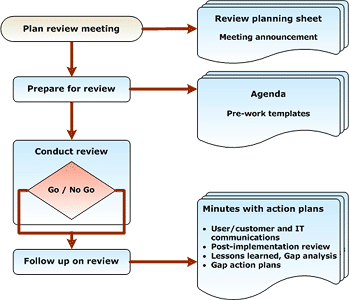As shown in the figure below, the Release Readiness Review is a four-step process that results in a decision to proceed (or not) with a particular release.

In this review, a specially formed review team evaluates three distinct aspects of release readiness:
- The operability and supportability of the release
itself.
- The readiness of the production environment (organization and
infrastructure) to support and operate the release.
- The readiness of the release strategy plans, including rollout
and rollback plans, training plans, and support plans.
The purpose of the Release Readiness Review is to confirm, or certify, these three items. An item can be considered ready for release when it meets business and IT needs and can support consistent, ongoing achievement of service level expectations.
Accordingly, the review results in a go/no-go decision about whether to deploy the release. If the decision is go, the release moves to rollout planning and preparations as driven by the release management team. Otherwise, the release is postponed until the necessary improvements take place, or it is cancelled.
While all of the Microsoft Operations Framework (MOF) operations management reviews (OMRs) involve risk management to some degree, the Release Readiness Reviews have by far the heaviest emphasis on risk management. This is because the act of introducing a new or updated release usually entails the greatest amount of uncertainty. The Release Readiness Review is the last opportunity to back out if the risks are unacceptable.